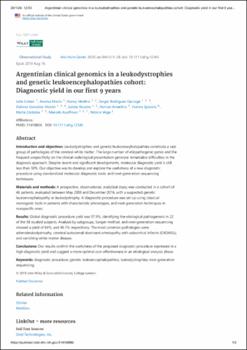| dc.contributor.author | Amartino, Hernán. | |
| dc.contributor.author | Kauffman, Marcelo. | |
| dc.contributor.author | Cohen, Cohen. | |
| dc.contributor.author | Et al. | |
| dc.date.accessioned | 2024-01-29T15:55:10Z | |
| dc.date.available | 2024-01-29T15:55:10Z | |
| dc.date.issued | 2020-01 | |
| dc.identifier.citation | Ann Hum Genet . 2020 Jan;84(1):11-28. | es |
| dc.identifier.issn | 1469-1809 | |
| dc.identifier.uri | https://riu.austral.edu.ar/handle/123456789/2675 | |
| dc.description | Disponible en: https://onlinelibrary.wiley.com/doi/epdf/10.1111/ahg.12345 | es |
| dc.description.abstract | Abstract
Introduction and objectives: Leukodystrophies and genetic leukoencephalopathies constitute a vast group of pathologies of the cerebral white matter. The large number of etiopathogenic genes and the frequent unspecificity on the clinical-radiological presentation generate remarkable difficulties in the diagnosis approach. Despite recent and significant developments, molecular diagnostic yield is still less than 50%. Our objective was to develop and explore the usefulness of a new diagnostic procedure using standardized molecular diagnostic tools, and next-generation sequencing techniques.
Materials and methods: A prospective, observational, analytical study was conducted in a cohort of 46 patients, evaluated between May 2008 and December 2016, with a suspected genetic leukoencephalopathy or leukodystrophy. A diagnostic procedure was set up using classical monogenic tools in patients with characteristic phenotypes, and next-generation techniques in nonspecific ones.
Results: Global diagnostic procedure yield was 57.9%, identifying the etiological pathogenesis in 22 of the 38 studied subjects. Analysis by subgroups, Sanger method, and next-generation sequencing showed a yield of 64%, and 46.1% respectively. The most common pathologies were adrenoleukodystrophy, cerebral autosomal-dominant arteriopathy with subcortical infarcts (CADASIL), and vanishing white matter disease.
Conclusions: Our results confirm the usefulness of the proposed diagnostic procedure expressed in a high diagnostic yield and suggest a more optimal cost-effectiveness in an etiological analysis phase.
Keywords: diagnostic procedure; genetic leukoencephalopathies; leukodystrophies; next-generation sequencing.
© 2019 John Wiley & Sons Ltd/University College London.
PubMed Disclaimer | es |
| dc.language.iso | en | es |
| dc.publisher | Wiley | es |
| dc.rights | Attribution-NonCommercial-NoDerivatives 4.0 Internacional | * |
| dc.rights.uri | http://creativecommons.org/licenses/by-nc-nd/4.0/ | * |
| dc.subject | Diagnostic procedure | es |
| dc.subject | Genetic leukoencephalopathies | es |
| dc.subject | Leukodystrophies | es |
| dc.title | Argentinian clinical genomics in a leukodystrophies and genetic leukoencephalopathies cohort: Diagnostic yield in our first 9 years | es |
| dc.type | Article | es |


